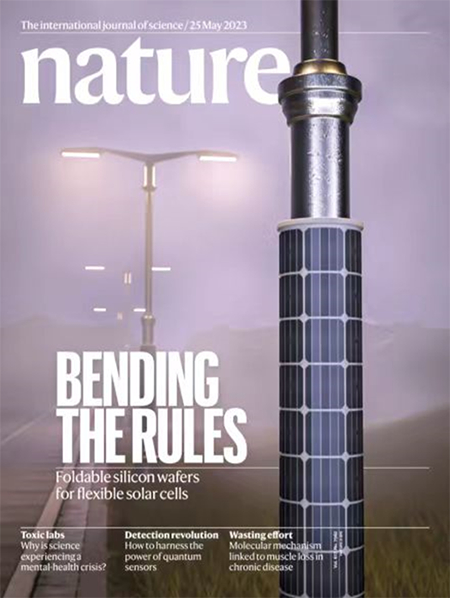Supported by the National Natural Science Foundation of China (Grant Nos. 51925208 and 62004208) and other fundings, researchers Zhengxin Liu and Zengfeng Di’s groups in Shanghai Institute of Microsystem and Information Technology, Chinese Academy of Sciences in collaboration with other scientists have made significant progress in the field of industrial-level flexible single-crystal silicon solar cells. Their research paper entitled "Flexible solar cells based on foldable silicon wafers with blunted edges" was published as a cover paper in Nature on May 24, 2023 (Figure1, link: http://doi.org/10.1038/s41586-023-05921-z).
In the 1950s, scientists from the Bell Lab invented single-crystal silicon solar cell, which converted solar energy into electricity. At that time, the pioneering photovoltaic conversion efficiency (PCE) was around 5%. Recently, the PCE of single-crystal silicon solar cells has boosted to 26.8% in China, approaching the theoretical limit of 29.4%, thanks to the collaborative innovations of material structure engineering and advanced equipment development. Meanwhile, the levelized cost of energy has decreased significantly, thus achieving grid parity in most regions of China. The market share of single-crystal silicon solar cells holds over 95% in the entire photovoltaic market, extensively applied in large-scale ground-mounted solar power plants and distributed photovoltaics. In addition, there exist a huge demand to develop flexible single-crystal silicon solar cells for wearable electronics, mobile communications, onboard mobile power, integrated photovoltaic buildings, aerospace flights, and other areas. However, single-crystal silicon itself is a brittle material which is prone to fracture under an external bending stress.
High-speed cameras found that the fracture of single-crystal silicon wafer under a bending stress always initiated from the "V"-shaped grooves at the edge of the wafer. This region was defined as the "mechanical weak region" of the wafer. To address the issue of mechanical weak region, the researchers used either wet chemical reactions or plasma reactions to transform the sharp "V"-shaped grooves on the edge surface and side surfaces of the silicon wafer into the smooth "U"-shaped grooves through isotropous reactions. The changes of structural symmetry on the wafer's edges at the mesoscale can turn the wafer's "brittle" fracture behavior into "elastic-plastic" secondary shear band fracture behavior. Therefore, the "flexibility" of the silicon wafer can be enhanced significantly, which allows 50-80 m single-crystal silicon solar cells to be curled like an A4 paper, with a bending angle exceeding 360 degrees (Figure 2).

Figure 1. Cover story of Nature: Foldable silicon wafers for flexible solar cells

Figure 2: Industrial-level flexible single-crystal silicon wafers and solar cells

Add: 83 Shuangqing Rd., Haidian District, Beijing, China
Postcode: 100085
Tel: 86-10-62327001
Fax: 86-10-62327004
E-mail: bic@donnasnhdiary.org
京ICP备05002826号 文保网安备1101080035号 Copyright 2017 NSFC, All Right Reserved